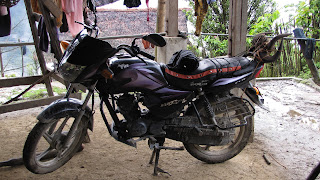Its Steinbeck when I get back to the dark already-misty Inspection 'Bungalow' in Bomdo village in Upper Siang; starry sky, the orion, jupiter, the big dipper, the works. There is no electricity and am heady with a drink of rice beer they serve here in copious quantities. Stomach's full of a pumpkin and smoked mithun meat meal with a tinge of the cinnamon-like Taari (a pentatomid bug also called gandhi pok) chutney.
The village is very different when there is no electricity, it is livelier with more conversations. People who would otherwise watch fake wrestling and soaps with lavish make-ups are talking; someone talks of the best places to get firewood for the winter from, others talk of a man who has hunted three wild pigs in a day (thats a record!), someones hunted a barking deer tonight and has arrived to gift the leg piece, about someone who has gone into the forests for four nights to lay cable traps for animals, about rice this year not being productive owing to the rains, about someone who got a lucky contract from the Junior Engineer–good money and so on and so forth. Good for me I understand only a little of the Adi they speak here or I could read the news about the village like those eccentric channels in the television!
For me, the evening began with a stroll close to the volleyball field near the Naamghar (the community hall) we have here in Bomdo, I met Jabo who promptly invited me over for a drink and I happily obliged. When I reach his home, he asks me to wait, for he had to have a team meeting about the hunt they are fortnightly on, they are to leave the next morning while the cock crows into the forests beyond the hills behind the village. His wife Olak had been searching for sticky-rice beer called Nogin locally for me and found enough. Jabo got back and announced he was off at 3 am for 3 nights to the Siku camp along the Angong river; a good 7 hour walk from the village for the Adis and a 10 hour walk for me.
Jarring, Jabo's brother is back and announces he ate out tonight at his cousins place where wild pig entrails were cooked. Home food to him was boring, but after he left, Jabo's mom had selected a prime mithun smoked meat slice to go with the tasteless pumpkin boiled earlier. Thats the thing here in Bomdo, one can go to a neighbors home and they oblige with food and drink, for the neighbour is a close relative too and anyway everyone in the village is related to everyone, often both through lineage and marriage. I am an outsider but was being provided a homely drink and a meal, nice!
Back in the 'Bungalow', its dark I can't even see my own fingers! Thankfully I am equipped for this; I have a solar charger that charges the phone that provides a torch and a kindle that provides good read and some music. Am back to ' The grapes of wrath'. Some say one should not read such books in which sorrow is so elegantly depicted when alone and far from home. But I slip and slide away into the story and into the night.






















